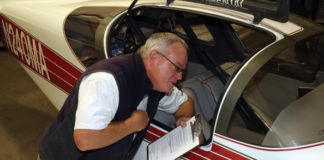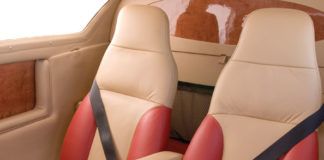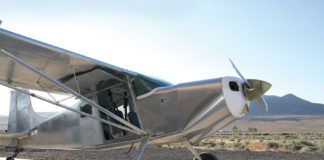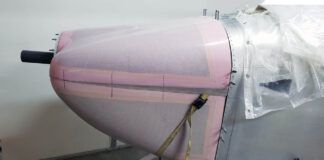When everyone else is obsessed with removing weight from their aircraft, an air compressor to drive two pneumatic cylinders seems an unusual addition. But then Ken Pollock is not your usual pilot. Having just graduated from West Point Military Academy in 1988, Ken was on his way to his first duty assignment when, overcome by too many hours at the wheel, he drifted off to sleep and woke up with a broken neck, no use of his legs, and little use of his arms and hands.
Recovery, such as it was, was slow, but the same grit that got Ken through his plebe year at West Point kicked in and, with the help of caregivers such as Jermain Silverio, he started the process of recovering what he could. After much physical therapy, Ken earned an MBA and was able to go snow skiing at Aspen with the Paralyzed Veterans of America, so flying didn’t seem altogether impossible.
Fast-forward to 2005 and the Internet. Kens father, James Pollock, had always wanted to fly, so Ken surfed the web looking for something that his dad might like and came across a Buckeye powered parachute in an online discussion group. As so often happens, especially in a web-accessing society, one link led to another, and suddenly Ken realized that with some modification, the Buckeye might be suitable for him.
One Thing Leads to Another
Ken arranged a demo ride, and he was hooked. “Once I saw a picture of a powered parachute, I searched for a local pilot,” he said. “Kevin Miller is an avid PPC pilot with a listing on the web. I called him immediately, and we agreed to meet. So 18 hours after I found out PPCs existed, I was flying.” Kens original motivation shifted when his dad had a change of mind and decided not to go for it, but Ken remained undeterred. “There’s not much I can do for fun, so although Dad opted out, I decided to pursue it for myself.”
The 50-mile drive from his home in Oakland to the nearest suitable field at Tracy, in Californias Central Valley, was not a problem. Kens van has been extensively modified to allow him that mobility. The other pilots were understandably skeptical, but as Ken described how he wanted to approach the problem, it didn’t sound quite so implausible.
When he asked, “Who should I get to instruct?” everyone pointed to Bob Schaible, owner of Professor Muldoons Hot Air Balloons & Flying Machines in Tracy. Still, Kens flight training was not going to take the usual path. Apart from his introductory flight with Kevin, Ken had never flown as a pilot or as a student before.
Many Mods to Make
The process of figuring out the modifications was time-consuming, with repeated trips to Aircrafters LLC in Watsonville, California, for adjustments. Ken has little strength in his arms and even less gripping power, so the first thing needed was a way of securing his hands onto the nosewheel steering lever and throttle. The solution was to fabricate a three-pin handle that allowed him to capture his wrist, preventing lateral motion. This is a standard modification for holding the steering wheel of a car, so transferring the existing technology was the answer.
“I went back and forth between Aircrafters, California Power Systems and Tracy Airport at least four times,” Ken said. “Each time, I would do static tests or rolling tests to demonstrate my improved ability to guide the craft.” Obviously, he wouldn’t be able to grab and pull the shrouds, and so entered the compressor and pneumatic air cylinders. Dave Saylor at Aircrafters mounted the controls for the cylinders between Kens knees, and then equipped them with extra long levers to minimize the force needed to actuate them.
Although the Buckeye has an optional air-steering kit, it works more as a trim system than a steering system. Ken would be working the compressor far beyond the original design parameters, so a bigger unit was installed along with a backup compressor, upgraded air lines and improvements to the electrical system. Next, the PTT switch had to be positioned at eye-level on the right down-tube. Because he has no real use of his thumb, this allowed Ken to push it with a knuckle. As it turned out, this was not the best position, but thats why its called Experimental.
Watsonville Airport is a bit too active with everything from gyroplanes to Gulfstream Vs in the pattern, so testing involved moving the aircraft back to Tracy, about 100 miles away. Four trips and lots of passes along the runway served notice that Ken was going to do this. Eventually, it all got sorted out, and the day of the first flight arrived.
The Big Day Looms
First flight for this airplane and pilot is something akin to what Wilbur and Orville did, but was unlikely to have occurred many times since. “Kevin Miller volunteered to test-pilot my modifications and fly it as I would have to,” Ken said. With that flight a success, the only thing left to do was, well, “Just do it!” But not quite.
Crosswind takeoffs are not a good idea when your wing is 25 feet above you. Weather cancelled the big day twice, but patience is Kens middle name. When the weather finally cooperated, Bob sent Ken down the runway for a couple of chuteless trips not unlike Tiger Woods taking a couple of practice swings before approaching the tee.
With Jermain Silverio and Bob Schaible to spread the chute, all that remained was for Ken to hit the throttle. The chute rose to full height, and he was off in about 100 feet, climbing to 400 feet with all the aplomb and confidence of anyone on a solo. (Think back to your own to understand this.)
Bob radioed him to turn back toward the field, and Ken made a turn, crossing over us as if on a bombing run. In short order Bob was able to cease his encouragement, leaving Ken to fend for himself.
Although he stayed over the field, after about 10 minutes Ken was no longer making circuits like a skater following the mob on a crowded rink. Hed made the transition from being a quasi-passenger with the airplane doing the flying, to being pilot in command. He did figure-eights and low passes, and it was not until one enthusiastic foray a bit further away that Bob gently reminded Ken to keep it in close. Twenty minutes for a solo seemed about right, so with a descent rate only a parachute can offer, Ken touched down and rolled out in less than 50 feet.
Nothing to It
Afterwards, Ken admitted that the landing was unintentional. He had planned to make a low pass, but had removed his hand from the throttle to push the PTT switch, and was unable to get back to the throttle as quickly as he thought he could. With a parachute deployed at all times, though, it cant get much safer. Had he not mentioned it, wed never have known.
As I was on my way home I found myself smiling and mentally reliving my own solo in response to Kens first effort. I remembered thinking: Am I really ready for this? What if I screw up? Hey, this thing is off the ground, now what? OK, stay in the pattern and maintain your altitude. But with the slow speed and wide-open spaces at Tracy, it was apparent that Ken almost got into cross-country mode during his flight, with that sense of independence and even a “Yeee-haaaa, Im doing it” feeling.
Since that first flight in November 2007, Ken has gone on to accumulate about 100 hours of flying time. He claims that his ultimate goal is to join the PPC caravan and fly in places like Bryce Canyon. Hell do it, too. Thats the kind of guy he is.
For more information on Buckeye, call 574/892-5460, or visit www.buckeye aviation.com. A direct link can be found at www.kitplanes.com.




